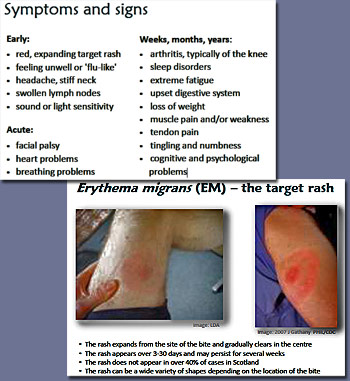A Hampshire hospital is to host the first national centre for Lyme disease, a vicious infection that can attack the nervous system and even cause death.
While the Health Protection Agency report fewer than 2,000 cases of Lyme disease per year in the UK, the number is on the rise and Hampshire is a hot spot.
Furthermore, the inherent problems with regard to diagnosing the disease; makes accurate statistics difficult to ensure.
 Unionsafety has previously reported in some detail on what can be a totally devastating disease both for the sufferer, and their family members and loved ones; and the treatments and diagnosis problems facing clinicians.
Unionsafety has previously reported in some detail on what can be a totally devastating disease both for the sufferer, and their family members and loved ones; and the treatments and diagnosis problems facing clinicians.
People working outdoors such as telephone engineers, postal staff, and farmers are at most risk, but the general public are at risk of Tick bites whenever they venture into parks and countryside, depending upon whereabout in the country they visit.
With most of the in-road into the disease coming out of research from the USA, the disease, its diagnosis and treatment remains controversial.
Dr Matthew Dryden, consultant microbiologist at Winchester’s Royal Hampshire County Hospital (RHCH), will head the National Lyme Disease Clinic from September, according to Hampshire’s Southern Daily Echo.
Dr Dryden is a leading authority on the disease which is spread by tick bites. He has seen 508 confirmed cases over his 20-year career at the RHCH.
He said:
“We do get to see quite a lot of patients here but we don’t have a proper clinic. It will be the first national Lyme disease referral service.”
The newspaper report goes on:
Dr Dryden believes the increase may be down to more people living in wooded areas, such as the New Forest.
The first symptom is a red circular skin rash which may subside after a week or two. A high temperature, muscle and joint pain may then follow. However, not every attack of the disease is accompanied with this rash which results in miss-diagnosis in many more cases than realised.
Whilst most infections are not serious, in extreme cases it can cause paralysis, encephalitis and meningitis.
It is caused by the bacteria Borrelia burgdorferi, found in the digestive system of deer, pheasants and mice. When a tick bites an animal carrying this bacteria, they can become infected with it.
The tick can transfer the bacteria by biting humans.
Leslie Fretton, 68, has just been diagnosed with Lyme disease. The retired carpenter, who lives near Andover, believes he was bitten in his garden.
He said:
“Just over two months ago my arm swelled up. After about five days it started to go down. I have felt rough ever since then.”
His symptoms included pins and needles in his hands and feet, trouble swallowing and walking.
“I could not move out of my bed, it absolutely drains you.”
Such is the concern for the rise in the number of patients presenting with symptoms, and the apparent lack of GP understanding of the disease in general in the UK, campaign groups and local authorities have produced warning posters and information leaflets which give advice about removing a Tick and the precaution that can be taken to minimise being bitten in the first place.
Advice leaflets and infrmation on Tick bites and Lyme Disease can be found in the E-Library Database here
A full report into Lyme Disease and a feature length documentary film can be read and viewed in this Unionsafety special report: Lyme Disease Invisible And Misdiagnosed Devastates Sufferers As NHS And Govt Remain Idle
See also: Lyme Disease – Patients Languish While Facts Are Buried
Source: Southern Daily Echo / Unionsafety


 Unionsafety has previously reported in some detail on what can be a totally devastating disease both for the sufferer, and their family members and loved ones; and the treatments and diagnosis problems facing clinicians.
Unionsafety has previously reported in some detail on what can be a totally devastating disease both for the sufferer, and their family members and loved ones; and the treatments and diagnosis problems facing clinicians.